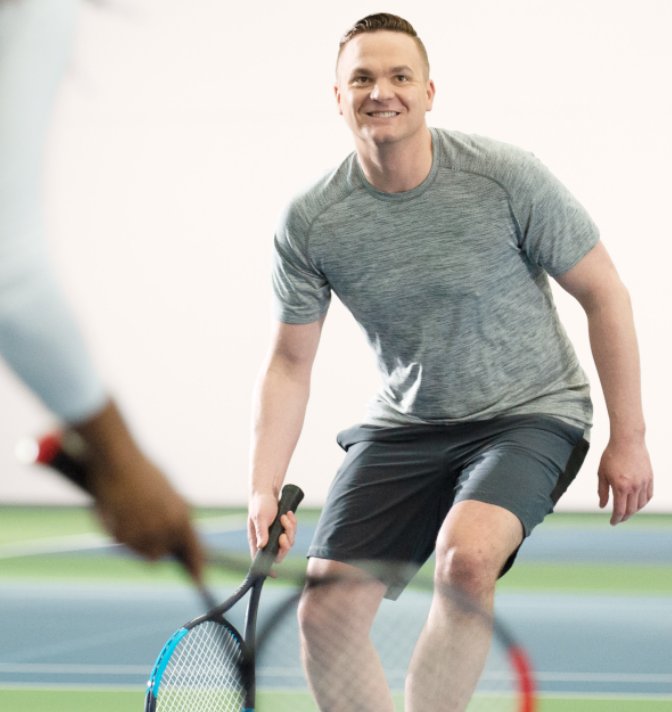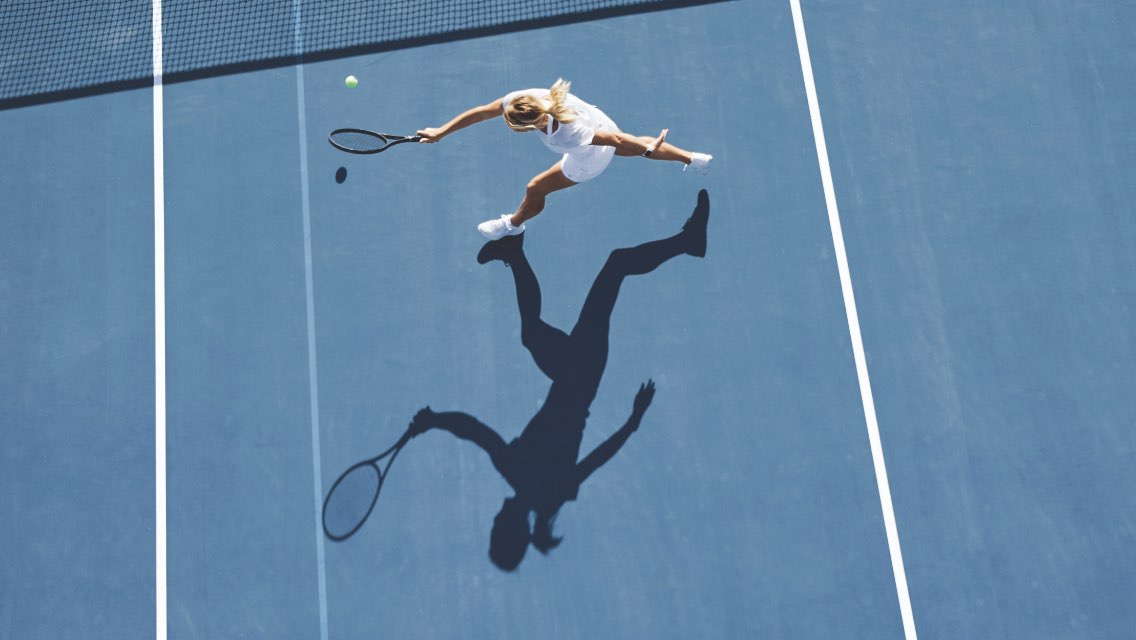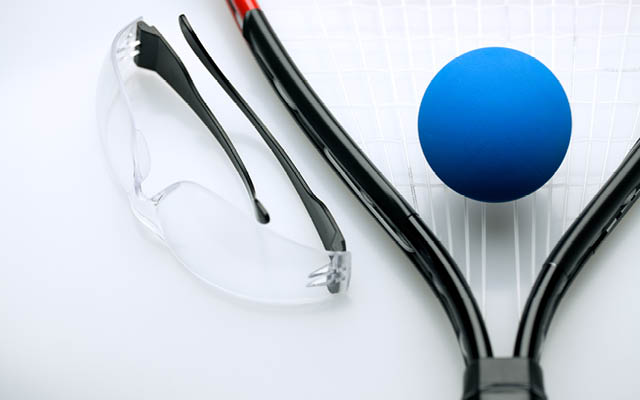Racquet sports, like tennis, pickleball, squash, and racquetball, can provide a strenuous full-body workout — so much so that hitting the fitness floor for a postmatch workout may not be a top priority.
But incorporating a sport-specific exercise routine for just 20 minutes two or three times per week can significantly boost your on-court performance and overall functional fitness, says Life Time tennis pro Joe Meier, CSCS.
Meier, who is also a master trainer, nutrition coach, and strength-and-conditioning specialist, recommends exercises that focus on building range of motion and stability, especially in the shoulders, hips, and core. “These are the areas of the body that power serves, ground strokes, volleys, and efficient movement patterns,” he says.
He also suggests footwork exercises to support flexibility and prevent overuse injuries. By building a strong foundation, you’ll start seeing on-court improvement.
The Workout
- Perform two to three sets of 10 reps per side of each exercise, two or three times per week. You can schedule this workout on off days from racquet sports or use it (or parts of it) as a prematch warm-up.
- Regardless of your level of fitness or expertise, Meier says, avoid training to exhaustion or muscle failure; you don’t need to spend longer than 20 minutes on each workout session to notice significant improvements.
- Perform each of these moves with the mindset that you’re preparing the muscles and joints for play.
Standing Shoulder External Rotation With Anchored Resistance
Strong external rotators are key for shoulder stability on every stroke, yet most players are weak in this area. This exercise can help.
- Begin standing tall, feet shoulder-width apart, with one hand holding onto a band anchored approximately shoulder-height in front of you. Take a step back to put tension on the band.
- Raise your elbow out to the side at shoulder height. Keeping a 90-degree angle at the elbow, rotate your hand and forearm backward against the band’s resistance, pause, and rotate forward while keeping your elbow still. Your elbow acts as the pivot point from which your hand and forearm move up toward the ceiling and down toward the anchor point in front of you.
- Avoid shrugging your shoulder upward or turning your trunk as you perform the exercise.
- Repeat on the opposite side.
Single-Arm Overhead Triceps Extension
This exercise focuses on your serving shoulder’s range of motion; it simulates the motion of “hitting up” on the ball toss.
- Stand upright, holding a dumbbell in one hand. Raise that arm straight up, bringing your bicep as close to your ear as possible.
- Keeping your bicep close to your ear, lower your hand back behind your head, mimicking the racquet drop of a serving motion.
- Keeping your elbow still, reach your hand toward the ceiling, simulating hitting up on the toss and working your tricep. Although this motion is quick when serving, with weight or resistance added, keep the movement slower and controlled.
- Repeat with your other arm.
Squat and Reach
This full-body move activates the muscles in your core, back, and shoulders, making it an ideal warm-up.
- Stand with your feet shoulder-width apart and squat down until both hands are touching the floor, placing your elbows inside your knees.
- Stay in a squat position and keep your left hand on the floor, gently pushing your left elbow outward, applying pressure on your left knee as you reach your right hand toward the ceiling. Allow your gaze to follow your reaching hand.
- You should feel the muscles stretching in your core, back and shoulders.
- Repeat on the opposite side, returning to a standing position between each rep.
Modifications:
- If a full squat is difficult or hurts your knees, modify by bending your knees slightly and instead of placing your hands on the floor, place your left hand on your calf. Perform the stretch from there.
- You can keep your feet flat on the floor, or raise your heels slightly while keeping your weight on the balls of your feet, whichever is more comfortable.
Star Lunge
Tennis requires movement in all directions, making this move a great warm-up or strength-focused exercise.
- Stand upright with your feet shoulder-width apart.
- Begin with your left leg as the anchor.
- Lunge forward with your right leg, allowing both knees to bend with your back knee hovering just above the ground.
- Push off your lunging leg to return to the starting position.
- Lunge to the side, then return to the starting position.
- Lunge behind you, then return to the starting position.
- Repeat, using your right leg as the anchor.
- Start this exercise slowly then build to using more explosive motion when returning to the starting position.
Palloff Press
Named after its inventor, physical therapist John Palloff, this is an anti-rotation hold exercise that helps develop a strong core, as well as increase stability between the lower and upper body.
- Using a cable system or band, stand with the anchor to one side at approximately chest height.
- Take a lateral step away from the anchor for resistance and place both hands on the band or pulley handle.
- Hold your hands close to your chest, standing with your feet at least shoulder-width apart and a slight bend in your knees.
- Push your hands straight out in front of your chest until your arms are straight, pause, and then pull them back in toward your chest, resisting rotation throughout. You will be holding against steady resistance from the side, while your arms move away from and back toward your chest.
- Repeat with anchor to your other side.
Crossover and Shuffle Recovery Step
This supports efficient lateral movement (for example, hitting the ball and recovering after hitting), which is important both in terms of covering the court quickly and moving efficiently — particularly over the course of a long match.
- Stand with your feet just outside of shoulder-width, knees bent. Make sure you have about five feet of space on each side of you.
- Take a quick crossover step by stepping one foot in front of the other, followed by one to two small shuffles, ending in a split step, or both legs landing together with a slight bend in the knees.
- Repeat immediately going in the other direction, starting with the crossover step again.
Split Step With Diagonal Leap
Practice maintaining your balance with this movement, improving your ability to make starts and stops — particularly when you’re approaching the net.
- Stand with your feet just outside of shoulder-width, knees bent. Make sure you have about five feet of space on each side of you.
- Bounce into a split step (both legs landing together with knees bent), then leap out diagonally, landing and balancing on one leg (as if you were stretching to hit a volley).
- Leaping to the right, you’ll land on your left leg. Let your heel land first and keep your hips back, allowing your hip and knee to absorb the landing.
- Bounce into a split-step and repeat on the other side.
This article originally appeared as “On-Court Advantage” in the April 2022 issue of Experience Life.






This Post Has 0 Comments